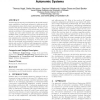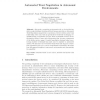1626 search results - page 22 / 326 » Computing the Types of the Relationships between Autonomous ... |
ICAC
2009
IEEE
14 years 3 months ago
2009
IEEE
Architectural monitoring and adaptation allows self-management capabilities of autonomic systems to realize more powerful adaptation steps, which observe and adjust not only param...
TNN
2010
13 years 3 months ago
2010
Soft computing (SC) emerged as an integrating framework for a number of techniques that could complement one another quite well (artificial neural networks, fuzzy systems, evolutio...
HRI
2010
ACM
14 years 3 months ago
2010
ACM
—Nonverbal behaviors serve as a rich source of information in inter human communication. In particular, motion cues can reveal details on a person’s current physical and mental...
IWSOS
2007
Springer
14 years 2 months ago
2007
Springer
Autonomic computing environments rely on devices that are able to make intelligent decisions without human supervision. Automated Trust Negotiation supports the cooperation of devi...
AAAI
2006
13 years 10 months ago
2006
Relationships between concepts account for a large proportion of semantic knowledge. We present a nonparametric Bayesian model that discovers systems of related concepts. Given da...


